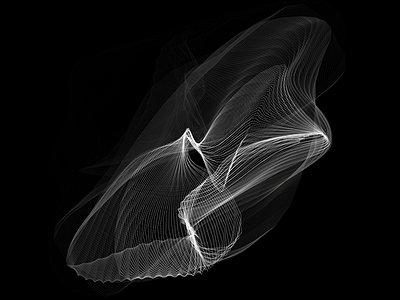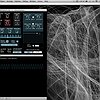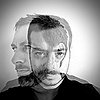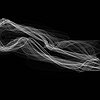Part 1
Names: Francesco Gagliardi (Sound Designer and Programmer), David Newman (Label Founder)
Company: Audiobulb
Nationality: Italian, British
Product: Lissajous, a real-time audio reactive graphics application built in Max/MSP
Website: http://www.audiobulb.com/
Interview Format: Sponsored Interview
David, your label began in 2003, what prompted you to branch into performance software? How does it fit in with the ethos of the label and what makes it different from the other software packages you offer?
It’s been an evolution; a progression of ideas and risks and an eagerness to take the label into new territories and be open to everything. Ever since its conception, Audiobulb was set up with a vision of supporting exploratory music – both in the form of inputs and outputs and bringing new perspectives to audio creation.
In the early days we released some free patches for MAX and software such a SOPHIA made by the wonderful Xik which proved really popular and it was nice to be able to supply sound-making tools and then release or promote the outputs from these tools.
I wanted to acknowledge the importance of software creativity and Audiobulb as well as having a Releases page for all our albums has also always had a Create page containing software and sound samples for artists and sound designers to engage with.
In 2010 we struck up a partnership with the extremely talented Christopher Hipgrave. A talented artist in his own right with beautiful ambient releases on Home Normal & Low Point, it was Chris’ passion that saw us developing AMBIENT, a stand-alone piece of software based on granular synthesis capable of taking any high-quality WAV file and splitting it up into millions of audio segments and creatively reassembling. Which brings me to Lissajous. When Francesco first contacted me, I was immediately struck by the opportunity to support his creative programming. Here was a piece of software that visualised sound and created these minimalistic arching patterns and lines flowing in time with the waveforms, distorting and buzzing when the artist drove the audio hard and sweeping and cycling when sine waves settled into their flow.
Lissajous turned out to be a success especially with later versions that allowed a full integration into the Max 4 Live Ableton Software.
The collaboration between software development and a music label begs the question, is there a co-authorship between musicians and machines? Is the act of writing software similar to composing a piece of music? Does a certain software inherently suggest certain creative decisions? How can the two mutually benefit each other?
Francesco: If I think about Ikutaro Kakehashi, Roland founder and engineer, I would surely reply Yes! He sculpted the sounds of techno with his TR series.
When you make a measurement, you create a reality; a reality that can be perceived differently from different minds and used in various ways. There is always something about the creator inside the instrument, inspiring new ways to use it with the new possibilities.
David: Francesco makes an important point about the audio processing possibilities of an instrument’s user interface and engagement; every instrument has its sweet spots and its unexpected side effects when pushed to its limits. Some artists will programme towards the mainstream potential and others will push the boundaries finding unexpected areas where sound and, in this case visuals, are both unusual and engaging. This is where the synergy lies in exploratory music; it has the potential to engage each listener in a different manner and interact with the context of their subjective experience of sound.
For artists and performers, this interaction has to be owned in the creative choices they make – the sounds they choose to employ or discard in the process of writing and arranging.
Francesco, was there a catalyst or particular event which triggered you to start developing Lissajous?
Francesco: It was in 2014 at the university when I got the idea; we were discussing audio waveforms and how to graphically depict the motion of the mass/spring system. While researching this field, I came across the Bowditch/Lissajous study of complex harmonic motions. This inspired me to apply the same concept in the audio field representing the trend of an audio signal (as an XY mode oscilloscope). Later on, I thought this was a really good way to perform in a live context without a separate visual artist on the side. I approached David about the development of Lissajous as a possible release on Audiobulb.
In which way did the colourful character of Jules Antoine Lissajous enter into the picture? Out of the unlimited ways to visualise a concept as intangible as music, how and why did you settle on the graphic curves of Lissajous?
Francesco: I’ve been always attracted by the sinuous motions of those figures, especially their cyclical quality and repetition. There is a simple, clean beauty in their visual representation. Lissajous creates “small universes” figures of dynamic beauty which I find aesthetically pleasing and fascinating to watch.
From your experience, what are some of the most inspiring overlaps between different senses - and what do they tell us about the way our senses work? What happens to sound at its outermost borders?
Francesco: I’m really curious to see what will happen when Virtual Reality (VR) can fully integrate with sound, perhaps sending us into an acousmatic reality where everything is self-generated by a neural intelligence. Even in 2017, multi-dimensional audio is still uncommon and unused. Almost everyone is still rolling stereo recordings while we could start working on y & z axes. I’m also fascinated by what quantum computing could bring to music in the future? We are just beginning to understand how our senses work and how all those new technologies can interact with music.
David: There is no doubt VR technologies will continue to accelerate. Bringing together the meaningful feedback between sound and visions is crucial in delivering an emotionally coherent context for the person engaged in the experience. Lissajous is a production tool – a creative platform and therefore it will always react dynamically to the controlled parameters of the artist.
People will demand VR experiences that enable them to create rather than passively engage in a universe created by an external author. After all, we are hard-wired to engage in experiences that we feel we can control in the here and now. Lissajous brings an immediate and dynamic output and that is exhilarating for both performers and audiences – especially when projected on a huge screen in a dark room with compelling music.
What were the most challenging aspects of the design process for Lissajous?
Francesco: Lissajous is a unique piece of software that needed to function both within the world of midi and visuals. A lot of work went into ensuring it was able to fulfil core characteristics such as playability and practical interactions with the device, such as saving pre-sets and mapping controls on a MIDI device. There was also the need to ensure video frames could be shared with other relevant applications in real time. Another really challenging aspect was the selection of complex oscillators, based on physical modelling synthesis. This sound choice helps to provide specific graphic parameters that result in either complex or smooth shapes.
David, how deeply involved were you in the development from conception to execution? What were the criteria you first had in mind when you approached the developer?
David: My role within Audiobulb is that of a curator. As such, I am always looking to work with creatives and support them to present their work in the best possible light. Through the website I give each artist and each programmer a home in the form of a release page. I work with them to develop promotional materials and to ensure release information is accurate and useful. For software releases, there is the need to ensure a manual is available to support users to get the best from the software. With Lissajous, I was involved in beta-testing with Francesco and providing him with feedback from a small group of beta-testers. Lastly, as always, my role is to celebrate the release of the software by telling the world about it! I do this through our mailing list and by posting in forums and blogs. With Lissajous we’ve had a really good response and people appreciate that it’s something different coming from an independent label like Audiobulb.
Can you talk about the way (manual, sequencing, midi-input, audio reactive) Lissajous syncs the visuals to music?
Francesco: Jules Antoine Lissajous had the great idea to graphically represent two oscillators in a different way, showing the displacement that corresponds to one oscillator along the x axis, while the other displacement is shown along y axis on a Cartesian plane (something like: x=sig1(horizontal), y=sig2(vertical)).
So, the picture depends on the relative timing of the two oscillators at any given microsecond. I built the software in Max/MSP. The video section is based on three 'Jitter objects' that allows me to process the signals and represent them in real time. Most of the physical oscilloscopes you see enable you to display one (x) or two (xy) audio signals at the same time, exactly as Lissajous does. But there are some more drawing styles to represent the audio function in Lissajous that you don't find on traditional oscilloscopes. These are Points, Lines, Line Stripes or Triangles. In that respect, we have created something visually different with more possibilities.
Describe the way the user can control the sonic/visual interactions? How does the image react to volume, waveform, and beat?
Francesco: Sounds are vibrations represented as waves and each sound has its own specific shape. In Physics the amplitude is the “maximum displacement or distance moved by a point on a vibrating body or wave” and in the Psychoacoustic field is perceived as volume. So, the amplitude determines the size of the renderings and the louder the sounds get, the more they are graphically magnified.
Let’s focus on wave shapes and take for example one sinewave and one cosinewave (it means a sinewave in anti-phase with the other), here. Now describe them as parametric equations on a Cartesian plane where “t” is Time:
x = cos(t)
y= sin(t)
0<=t<=2π
What we get is a circle as represented by this graph here.
Some more basic figures based on sine, triangle or square wave can be found here.
These concepts are the building blocks of Lissajous.
There are two different versions of Lissajous. Can you briefly explain the main differences between them and whom they'd be suited for?
Francesco: With the Lissajous Package you get one Standalone and two Max for Live (M4L) devices (Live is a popular software for music production, creation and performance). The standalone instrument is fun to use and puts the artist in control of the device in the same way they might play a synth. However, with the M4L versions, you can automate everything on the instrument giving you 100% control. Therefore, the M4L versions offer more possibilities such as mapping external midi devices, saving pre-sets, LFO time-sync etc. Furthermore, we recently added another M4L tool called L-Scope that can process any desired audio input from any source (e.g. wav audio, sample clips, vst etc.) This means the visual aspects of Lissajous can function as a separate unit from its in-built synth and be applied to any audio the artist chooses.
Lissajous is a very versatile package. With its different versions, there is something for everyone. An artist can turn up, plug in their laptop and present cutting-edge audio/visuals right there.
Tell us some of the interesting ways your customers or artist roster have used Lissajous in their music projects?
Francesco & David: Many musicians have got in touch to show how they’ve employed Lissajous in their work. There are even cases of people writing and releasing entire albums with just this software. Many use it for live performances and one artist used a visual still from the software as a record cover for their album. Others have used it for art installations in galleries and even body performances where the video rendering has been superimposed on the body shape of a dancer. We are very proud of this and hope more users will enjoy Lissajous and use it to make something unique.
It is remarkable, in a way, that we have arrived in the 21st century with the basic concept of music still intact. Do you have a vision of music, an idea of what music could be beyond its current form?
Francesco: This sentence reminds me of “noise music”, and I use quotation marks because it could be an oxymoron as it calls into question the classic definition of music and the classic definition of noise. Our way of listening to music has already changed, and will keep changing over the years, arm-in-arm with the technological development. The boundaries between what constitutes and separates music and noise is now more blurred than ever, but there will always be an interest in bringing sound to play in an aesthetically interesting way.
David: I think we are hard wired to pay attention to important stimuli and sound is one of key primary senses. Music is a way of bringing that sense to life in a manner that interests or, even better, enthrals the listener. I agree with Francesco that the boundaries of what music can be have been expanded and this has occurred through the creation of new technologies. Today's artists and sound designers have access to a huge array of sounds that were not available in the past. Every artist has the opportunity to work with combinations of traditional and contemporary sound – bringing together combinations of rhythm, texture and narrative/arrangement to evoke an emotional response within the listener.
While 15 Questions will feature sponsored interviews with labels, brands and individuals from time to time, these are subject to the same selection and editorial review process as our regular features.







